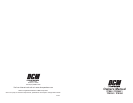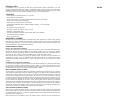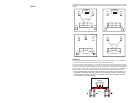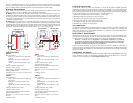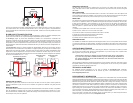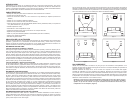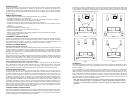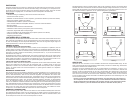
INTRODUCTION
Congratulations on your purchase of DCM Time Frame Evolution Series Loudspeakers. Your new
speakers represent the latest technologies in loudspeaker design and manufacturing. They will provide
outstanding performance and years of listening enjoyment. Please take time to read through this manual
thoroughly to insure you get maximum performance out of your new loudspeakers.
FEATURES
• Video shielding for placement near a TV or monitor
• 30 mm Teteron
®
dome tweeter
• Kevlar cone midrange in a separate sealed enclosure (TFE100 and TFE200)
• Kevlar cone woofer (TFE60 and TFE60C)
• Glass fiber cone woofer (TFE100 and TFE200)
• Internally braced Medium Density Fiberboard (MDF) cabinets, 1" thick front baffle
• Bi-ampable
• Nickel-plated 5-way binding posts
• Rich Dark Cherry finish to blend in with any decor
• Perforated, radiused steel grille
• Feet with adjustable or removable carpet spikes (TFE100 and TFE200)
• Foam feet (TFE60 and TFE60C)
• DCM 10 year warranty
SPEAKER PLACEMENT
All DCM Time Frame Evolution Series Loudspeakers have been engineered to combine deep, powerful
bass with crisp, natural high frequency performance. Because there are many factors that affect loud-
speaker performance, there is no universal rule for speaker location. Best results will be obtained with
some experimentation using the following guidelines.
HOME THEATER SYSTEM
FRONT LEFT AND RIGHT CHANNELS
To achieve the most realistic front image, position the speakers so that an equilateral triangle is formed
between the front left and right speakers and the listening position (Figure 1). Turning the speakers
slightly inward towards the listening position can improve the image focus. Set the surround processor or
receiver to the "large" setting on the "front speaker size" (or similar description) control.
Bass loudness can be increased by moving the speakers closer to the rear wall. This sometimes can
degrade the front image. Use your judgement as to what location best fits your preference. We recom
-
mend that the speakers be kept at least 24" from the rear wall and 36" from the side walls for optimal
imaging.
SURROUND LEFT AND RIGHT CHANNELS
If you are using the TFE60, TFE100 or TFE200 for rear channel speakers, they should be placed along
the side walls and slightly behind the listening position (Figure 1). If this is not practical, they can be
placed along the rear wall to either side of the listening position (Figure 2). For best results, the surround
speakers should be spaced equal distances from the listening position.
MULTI-CHANNEL AUDIO SYSTEM
The TFE Series is engineered to deliver all the definition, bandwidth and dynamic range of 5.1 channel
audio (whether SACD or DVD-Audio) with astonishing realism. In fact both the TFE100 and TFE200 have
sufficient low frequency extension that the user has the option of eliminating the subwoofer and just use
five TFE100's or TFE200's for the complete system. Be sure that your surround processor or receiver
has sufficient bass management capability to direct full range signals to the five main speakers if you are
not using a subwoofer (See Figure 3). Both models are identically timbre-matched so that a combina-
tion of TFE100's and TFE200's can be used in a five channel system with the result being a seamless
three dimensional image and total musical envelopment. For example, three TFE200's could be used for
the front left, right and center channel speakers, and two TFE100's for the left and right rear speakers.
Alternatively, TFE100's and TFE200's could be used for the front left and right speakers, TFE60C for the
center channel speaker and TFE60's for the left and right rear speakers.
TWO CHANNEL STEREO SYSTEM
When using the TFE60, TFE100 or TFE200 in a two channel stereo system, to achieve the most realistic
stereo image, position the speakers so that an equilateral triangle is formed between the speakers and
the listening position (Figure 4). Turning the speakers slightly inward towards the listening position can
improve the stereo image focus.
Bass loudness can be increased by moving the speakers closer to the rear wall. This sometimes can
NOTES



